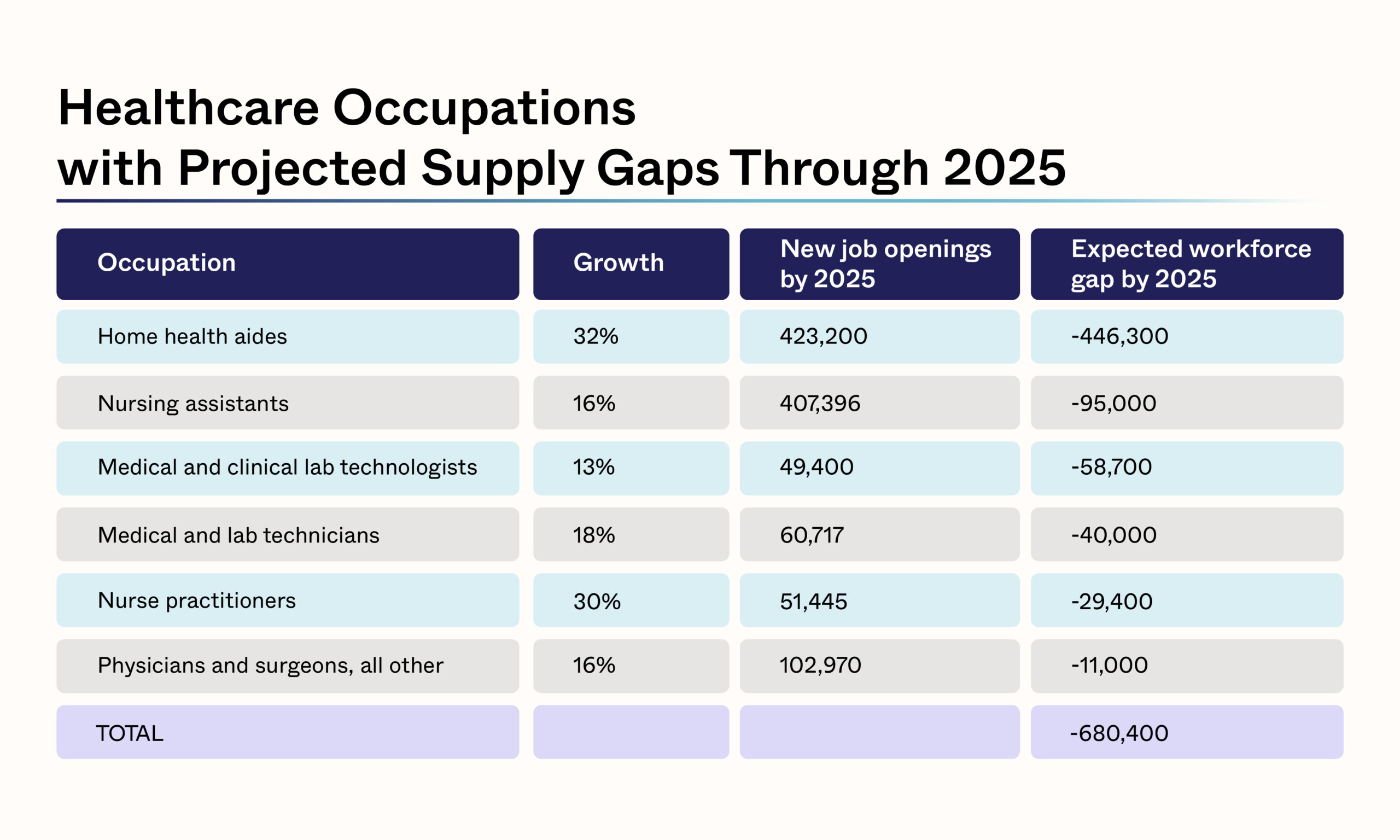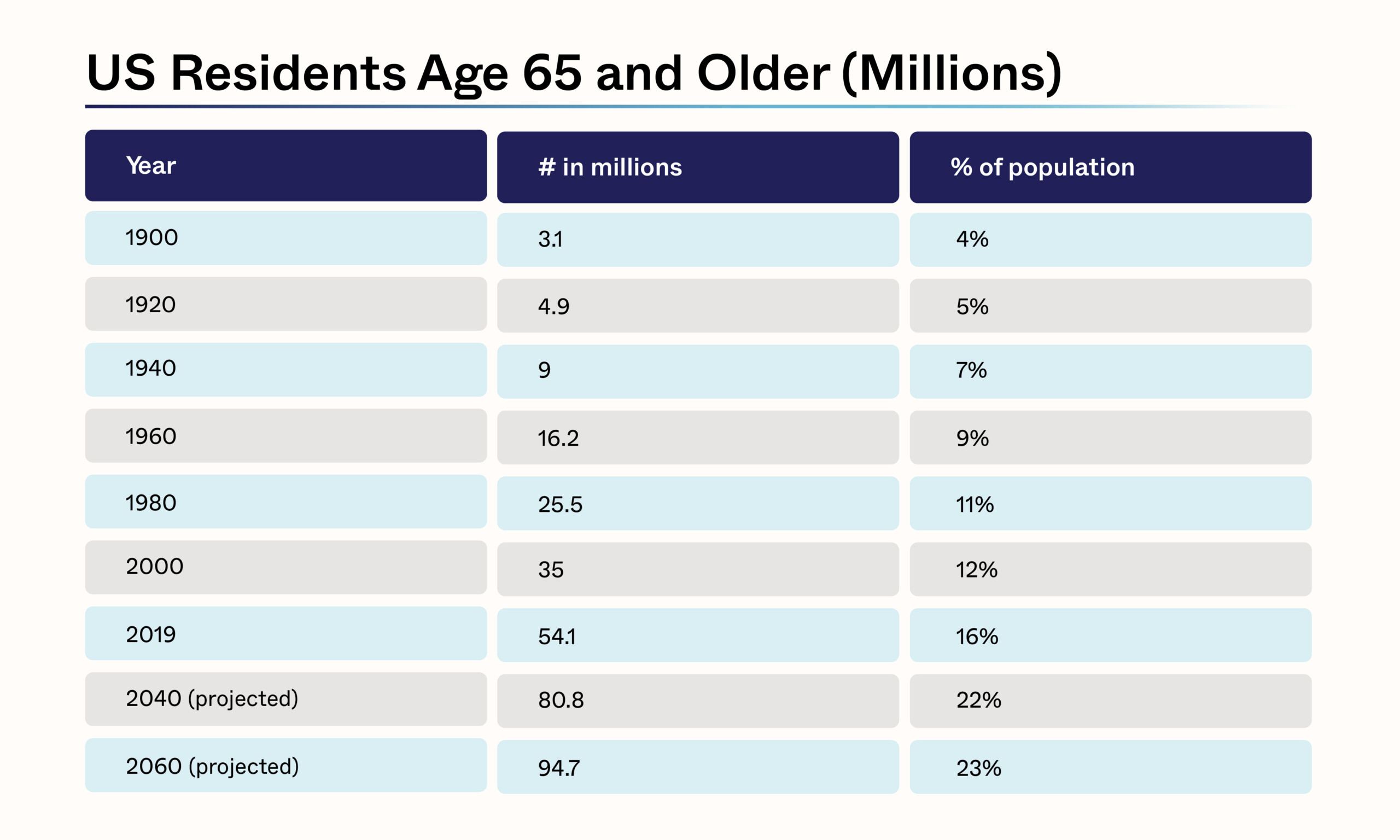The healthcare industry in the United States continues to struggle, with COVID-19 showing no signs of disappearing anytime soon. And to complicate matters, healthcare employment remains below pre-pandemic levels.
Accounting for 18% of its gross domestic product (GDP), the healthcare industry is ironically the nation’s largest employer. In total, more than 18 million healthcare workers (80% women) are employed in a range of roles, including registered nurses (RNs), home health aides, and medical assistants. Yet, the nation’s healthcare sector has been experiencing a severe talent shortage, exacerbated by a variety of factors on both the supply and demand sides.

Source: US Bureau of Labor Statistics
Pre-Existing Conditions
While no one could have predicted the impact of the pandemic, healthcare industry stakeholders had raised concerns about labor shortages prior to 2020. In 2019, the Association of American Medical Colleges (AAMC) predicted a shortfall of up to 124,000 physicians by 2034. Perhaps more dramatic, however, is a 2018 Mercer report predicting a shortage of nearly half a million home health aides, 95,000 nursing assistants, and more than 29,000 nurse practitioners – a shortfall of more than 680,000 medical professionals – by 2025.

Even before the pandemic, patients were already feeling the pinch of a labor shortage. A 2019 public opinion poll found 35% of respondents had trouble finding a doctor. COVID-19 only worsened an already unstable situation.
Burnout Flares Up
By early 2020, when COVID-19 first appeared in the US, medical facilities were already understaffed and overworked. According to the AAMC’s National Sample Survey of Physicians 2019 survey, 40% of physicians experienced burnout at least once a week. And, over the past few years, the pandemic has only added to the tremendous pressure healthcare workers experience. In a 2021 study, a majority of physicians reported experiencing significant psychiatric symptoms, including anxiety (75%) and depression (74%). A cross-sectional 2020 study found nearly 50% of healthcare workers suffering from burnout.
Given the rate of burnout across job profiles, it is probably not surprising that a whopping 47% of healthcare workers plan to leave their jobs in the next few years. One-third plan to move to a similar role, while 39% will leave the profession (21% due to retirement).
Healthcare workers expecting to leave their role in the next 2-3 years plan to:
- Stay in a similar role, but move to another healthcare setting: 33%
- Retire: 21%
- Move to another healthcare related job impacting patient care: 20%
- Move to a non-healthcare related job: 13%
- Do something else: 5%
- Take a leave of absence/sabbatical: 2%
- Don’t know: 6%
Source: Clinician of the Future Report 2020
According to AAMC President and CEO David J. Skorton, MD, COVID-19-related burnout may prompt healthcare workers to decrease their hours or retire sooner – creating long-term concerns in addition to shorter-term worries about morale, efficiency, and quality of care.
Aging Matters
Yes, pandemic-related concerns may have added to a pre-existing shortage, nudging workers out of the industry, but population growth and aging remain primary drivers for demand. During 2019-2032, the US population is expected to grow by more than 10% (328 million to 363 million), with a projected 42% increase in those aged 65 and older. Demand for physicians and other healthcare professionals will continue to increase – particularly general practitioners and specialists that care for older Americans.

Source: US Census Bureau, Population Estimate and Projections and Intercessional Tables
Large-scale retirement among physicians is also driving demand in the sector. Forty percent of physicians practicing in the US will be 65 or older in the next decade. Similarly, more than half (59%) of registered nurses are over the age of 50. Not only will the sector be understaffed, but new practitioners will lose access to the accumulated knowledge of the previous generation – a form of “brain drain.”
Let’s dive into the numbers, with the latest talent sourcing and recruitment advertising benchmarks!
Ready to Let the Data Do the Talking?
The Learning Curve
The healthcare industry is shorthanded. Burnout is on the rise. The nation’s population is living longer, with more chronic diseases. And half of physicians and RNs are nearing retirement. What about the next generation of medical professionals?
As of 2020, the AACN reported enrollment increases in bachelor’s degree RN (5.6%), master’s (4.1%), and Doctor of Nursing Practice (8.9%) programs. However, this is a far cry from the number of nurses required over the coming decade. A nation-wide shortage of clinical sites, faculty, and resources present major roadblocks to educating the next generation. In fact, more than 80,000 applicants were turned away from schools of nursing largely because of educational constraints.
Resuscitating Recruitment
Whether due to illness or burnout, the long-term impact of current healthcare labor shortages is likely to be felt for many years to come. Given the current landscape, however, recruiters in the healthcare industry are hard-pressed to identify and hire candidates. How can talent sourcing professionals optimize their efforts and continue to find the best talent despite ongoing budget cuts?
Successful staffing now requires an understanding of industry data and applicant behavior. Only then can talent acquisition professionals set market-driven goals, manage stakeholder expectations, and benchmark job ad performance.
To get a headstart in the right direction, request a demo with us today. And don’t forget to follow us on Twitter and LinkedIn for more insightful news on the latest happenings in the labor market.














